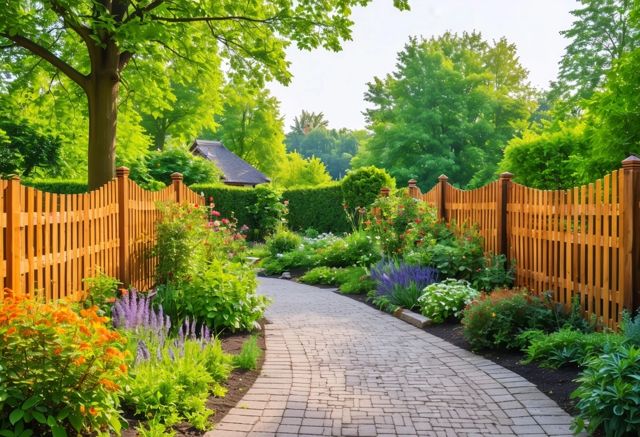The best wood types for fencing are cedar, known for its natural beauty and resistance to decay and insects, and redwood, prized for its rich color and durability. Pine offers a budget-friendly option with pressure-treated durability, while cypress provides natural resistance to pests and decay.
1. Cedar Fencing
Cedar brings natural beauty and built-in resistance to decay and insects, making it an excellent fencing option for those seeking longevity with minimal upkeep.
- Durability: Cedar fences can last up to 30 years.
- Cost: Averages $33 per linear foot.
- Types: Western red cedar and white cedar. White cedar is better if planning to paint.
- Moisture Resistance: Ideal for wetter climates.
- Maintenance: Requires periodic sealing to maintain its color and prevent rot in moist soil conditions.
Cedar’s stability helps prevent warping and shrinking, ensuring a sturdy and attractive fence over time. This wood’s natural oils enhance its durability and help keep insects at bay, making it a reliable choice for most environments.

2. Redwood Fencing
Redwood has a rich color and natural resistance to pests and decay, making it a premium fencing material that adds elegance to any property.
- Natural Beauty: Redwood’s deep, rich hues enhance the visual appeal of any yard or garden.
- Durability: This wood type resists warping, shrinking, and cracking, ensuring longevity.
- Pest Resistance: Naturally deters insects, reducing the need for chemical treatments.
- Low Maintenance: Withstanding moisture and decay, redwood fences need less frequent upkeep.
- Eco-Friendly: Often sourced from sustainably managed forests, making it a greener option.
Investing in redwood fencing brings aesthetic and functional benefits, enhancing privacy and adding value to your property.
3. Pine Fencing
Pine is a versatile and popular choice for fencing projects. Pine is often pressure-treated to resist decay, insects, and weather, greatly enhancing its durability and longevity.
Key Benefits:
- Affordability: Pine fences are budget-friendly.
- Durability: Pressure-treated to withstand harsh conditions.
- Customizable: Easily painted or stained to suit different styles.
Pine’s light natural color allows for various finishes, letting homeowners match their fence to their homes and landscapes with ease. Despite its affordability, it provides quality and longevity expected in a reliable fencing solution.

4. Spruce Fencing
Spruce offers a budget-friendly solution commonly used for stockade and picket fences, balancing cost with visual appeal.
Spruce requires regular maintenance to prevent rot and extend its lifespan:
- Annual inspection: Check for any signs of damage or decay.
- Sealant application: Apply a water-repellent sealant to protect against moisture.
- Prompt repairs: Fix any minor damages immediately to avoid larger issues.
Spruce fences blend well with various property styles, making them a versatile choice.

5. Cypress Fencing
Cypress wood contains cypretine, a natural preservative that makes it resistant to insects and decay, offering a unique and durable fencing option.
- Natural Preservative: Cypretine provides resistance to insect damage and rot.
- Durability: Can withstand harsh weather conditions, offering long-lasting protection.
- Aesthetic Appeal: Cypress has a pleasant, warm appearance enhancing the look of your property.
For homeowners, property managers, and contractors looking for reliable and attractive wood fencing, explore our expert craftsmanship and fencing solutions.

FAQ
What are the benefits of choosing cedar for fencing?
Cedar is naturally resistant to decay and insects, making it a durable and long-lasting choice. It can last up to 30 years and is ideal for wetter climates due to its moisture resistance. Cedar also requires periodic sealing to maintain color and prevent rot.
How much does a cedar fence cost?
The average cost of a cedar fence is $33 per linear foot.
What types of cedar are best for fencing?
Western red cedar and white cedar are popular. White cedar is particularly suitable if you plan to paint your fence.
What makes redwood fencing a premium choice?
Redwood is distinguished by its rich color, natural pest and decay resistance, and its ability to resist warping, shrinking, and cracking. It requires less maintenance and is often sourced from sustainably managed forests.
How does the price of redwood fencing compare to other types?
Redwood is more expensive due to its high quality and longevity but offers significant aesthetic and functional benefits.
Is pine a good option for fencing?
Yes, pine is a versatile, budget-friendly choice. It is often pressure-treated to resist decay, insects, and weather, making it a durable and customizable option that can be easily painted or stained.
What maintenance does spruce fencing require?
Spruce fencing needs regular maintenance, including annual inspections, applying a water-repellent sealant, and prompt repairs of any minor damages to prevent larger issues.
Why choose cypress for fencing?
Cypress contains cypretine, a natural preservative that makes it resistant to insects and decay. It is durable, can withstand harsh weather, and has a warm appearance that enhances your property’s look.

